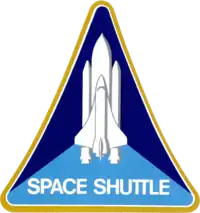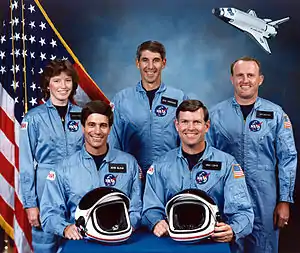| Names | Space Transportation System |
|---|---|
| Mission type | Communications satellites deployment (planned) |
| Operator | NASA |
| Mission duration | 7 days, 7 hours, 51 minutes, 51 seconds (planned) |
| Spacecraft properties | |
| Spacecraft | Space Shuttle Columbia (planned) |
| Launch mass | 1,217,990 kg (2,685,210 lb) |
| Landing mass | 90,584 kg (199,704 lb) |
| Payload mass | 21,937 kg (48,363 lb) |
| Crew | |
| Crew size | 7 (planned) |
| Members | Michael L. Coats John E. Blaha Robert C. Springer Anna L. Fisher James F. Buchli Pratiwi Sudarmono Nigel R. Wood |
| Start of mission | |
| Launch date | 24 June 1986, 13:09:00 UTC (planned) |
| Rocket | Space Shuttle Columbia |
| Launch site | Kennedy Space Center, LC-39B |
| Contractor | Rockwell International |
| End of mission | |
| Landing date | 1 July 1986, 21:00:51 UTC (planned) |
| Landing site | Kennedy Space Center, Runway 15 |
| Orbital parameters | |
| Reference system | Geocentric orbit (planned) |
| Regime | Low Earth orbit |
| Perigee altitude | 285 km (177 mi) |
| Apogee altitude | 295 km (183 mi) |
| Inclination | 28.45° |
| Period | 90.40 minutes |
 Space Shuttle patch  Back row: Anna L. Fisher, Robert C. Springer, James F. Buchli Front row: John E. Blaha and Michael L. Coats | |
STS-61-H was a NASA Space Shuttle mission planned to launch on 24 June 1986 using Columbia. However, it was canceled after the Challenger disaster.
Crew
| Position | Astronaut | |
|---|---|---|
| Commander | Would have been second spaceflight | |
| Pilot | Would have been first spaceflight | |
| Mission Specialist 1 | Would have been first spaceflight | |
| Mission Specialist 2 | Would have been second spaceflight | |
| Mission Specialist 3 | Would have been third spaceflight | |
| Payload Specialist 1 | Would have been first spaceflight | |
| Payload Specialist 2 | Would have been first spaceflight | |
Backup crew
| Position | Astronaut | |
|---|---|---|
| Payload Specialist 1 | Would have been first spaceflight | |
| Payload Specialist 2 | Would have been first spaceflight | |
Crew notes
Before Buchli was assigned to STS-61-H, Norman E. Thagard was the potential Mission Specialist 3 for this flight.
Mission objectives
The main task of the mission was to bring two commercial satellites into orbit – Palapa B3 and Westar-6S, and military communication satellite - Skynet-4A, The British Skynet and the Indonesian Palapa were supposed to be accompanied by an astronaut from the two countries.
After the Challenger disaster, the deployment of commercial satellites by the Space Shuttle was stopped, and for several years no international astronauts were nominated. Thus, neither the British nor the Indonesian payload specialists got a second chance for a spaceflight. The NASA crew however stayed together and participated in a 56-hour-long simulated mission known as STS-61-M(T) in 1987. The crew finally flew on STS-29, with Anna L. Fisher being replaced by James P. Bagian.
Skynet 4A was launched on 1 January 1990 with a Titan III, Westar-6S was renamed Galaxy-6 and launched on 12 October 1992 by an Ariane 44L. Palapa-B3 was renamed to Palapa B2P and was launched on 20 March 1987 with a Delta-3920.
.jpg.webp)